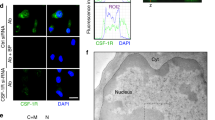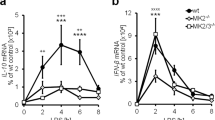Abstract
In addition to their cytoprotective role in stressful conditions, heat shock proteins (HSPs) are involved in specific differentiation pathways, for example, we have identified a role for HSP90 in macrophage differentiation of human peripheral blood monocytes that are exposed to macrophage colony-stimulating factor (M-CSF). Here, we show that deletion of the main transcription factor involved in heat shock gene regulation, heat shock factor 1 (HSF1), affects M-CSF-driven differentiation of mouse bone marrow cells. HSF1 transiently accumulates in the nucleus of human monocytes undergoing macrophage differentiation, including M-CSF-treated peripheral blood monocytes and phorbol ester-treated THP1 cells. We demonstrate that HSF1 has a dual effect on SPI1/PU.1, a transcription factor essential for macrophage differentiation and whose deregulation can lead to the development of leukemias and lymphomas. Firstly, HSF1 regulates SPI1/PU.1 gene expression through its binding to a heat shock element within the intron 2 of this gene. Furthermore, downregulation or inhibition of HSF1 impaired both SPI1/PU.1-targeted gene transcription and macrophage differentiation. Secondly, HSF1 induces the expression of HSP70 that interacts with SPI1/PU.1 to protect the transcription factor from proteasomal degradation. Taken together, HSF1 appears as a fine-tuning regulator of SPI1/PU.1 expression at the transcriptional and post-translational levels during macrophage differentiation of monocytes.
This is a preview of subscription content, access via your institution
Access options
Subscribe to this journal
Receive 12 print issues and online access
$259.00 per year
only $21.58 per issue
Buy this article
- Purchase on Springer Link
- Instant access to full article PDF
Prices may be subject to local taxes which are calculated during checkout








Similar content being viewed by others
References
Joly AL, Wettstein G, Mignot G, Ghiringhelli F, Garrido C . Dual role of heat shock proteins as regulators of apoptosis and innate immunity. J Innate Immun 2010; 2: 238–247.
Ribeil JA, Zermati Y, Vandekerckhove J, Cathelin S, Kersual J, Dussiot M et al. Hsp70 regulates erythropoiesis by preventing caspase-3-mediated cleavage of GATA-1. Nature 2007; 445: 102–105.
de Thonel A, Vandekerckhove J, Lanneau D, Selvakumar S, Courtois G, Hazoume A et al. HSP27 controls GATA-1 protein level during erythroid cell differentiation. Blood 2010; 116: 85–96.
Didelot C, Lanneau D, Brunet M, Bouchot A, Cartier J, Jacquel A et al. Interaction of heat-shock protein 90 beta isoform (HSP90 beta) with cellular inhibitor of apoptosis 1 (c-IAP1) is required for cell differentiation. Cell Death Differ 2008; 15: 859–866.
Akerfelt M, Morimoto RI, Sistonen L . Heat shock factors: integrators of cell stress, development and lifespan. Nat Rev Mol Cell Biol 2010; 11: 545–555.
Anckar J, Sistonen L . Regulation of HSF1 function in the heat stress response: implications in aging and disease. Annu Rev Biochem 2011; 80: 1089–1115.
Page TJ, Sikder D, Yang L, Pluta L, Wolfinger RD, Kodadek T et al. Genome-wide analysis of human HSF1 signaling reveals a transcriptional program linked to cellular adaptation and survival. Mol Biosyst 2006; 2: 627–639.
Moreau-Gachelin F, Tavitian A, Tambourin P . Spi-1 is a putative oncogene in virally induced murine erythroleukaemias. Nature 1988; 331: 277–280.
Koschmieder S, Rosenbauer F, Steidl U, Owens BM, Tenen DG . Role of transcription factors C/EBPalpha and PU.1 in normal hematopoiesis and leukemia. Int J Hematol 2005; 81: 368–377.
Rosenbauer F, Wagner K, Kutok JL, Iwasaki H, Le Beau MM, Okuno Y et al. Acute myeloid leukemia induced by graded reduction of a lineage-specific transcription factor, PU.1. Nat Genet 2004; 36: 624–630.
Tatetsu H, Ueno S, Hata H, Yamada Y, Takeya M, Mitsuya H et al. Down-regulation of PU.1 by methylation of distal regulatory elements and the promoter is required for myeloma cell growth. Cancer Res 2007; 67: 5328–5336.
Leddin M, Perrod C, Hoogenkamp M, Ghani S, Assi S, Heinz S et al. Two distinct auto-regulatory loops operate at the PU.1 locus in B cells and myeloid cells. Blood 2011; 117: 2827–2838.
Bonadies N, Neururer C, Steege A, Vallabhapurapu S, Pabst T, Mueller BU . PU.1 is regulated by NF-kappaB through a novel binding site in a 17 kb upstream enhancer element. Oncogene 2010; 29: 1062–1072.
McMillan DR, Xiao X, Shao L, Graves K, Benjamin IJ . Targeted disruption of heat shock transcription factor 1 abolishes thermotolerance and protection against heat-inducible apoptosis. J Biol Chem 1998; 273: 7523–7528.
Zheng H, Li Z . Cutting edge: cross-presentation of cell-associated antigens to MHC class I molecule is regulated by a major transcription factor for heat shock proteins. J Immunol 2004; 173: 5929–5933.
Sordet O, Rebe C, Plenchette S, Zermati Y, Hermine O, Vainchenker W et al. Specific involvement of caspases in the differentiation of monocytes into macrophages. Blood 2002; 100: 4446–4453.
Koster RW, Fraser SE . Tracing transgene expression in living zebrafish embryos. Dev Biol 2001; 233: 329–346.
Mezger V, Bensaude O, Morange M . Unusual levels of heat shock element-binding activity in embryonal carcinoma cells. Mol Cell Biol 1989; 9: 3888–3896.
Droin N, Jacquel A, Hendra JB, Racoeur C, Truntzer C, Pecqueur D et al. Alpha-defensins secreted by dysplastic granulocytes inhibit the differentiation of monocytes in chronic myelomonocytic leukemia. Blood 2010; 115: 78–88.
Creyghton MP, Cheng AW, Welstead GG, Kooistra T, Carey BW, Steine EJ et al. Histone H3K27ac separates active from poised enhancers and predicts developmental state. Proc Natl Acad Sci USA 2010; 107: 21931–21936.
Guery L, Benikhlef N, Gautier T, Paul C, Jego G, Dufour E et al. Fine-tuning nucleophosmin in macrophage differentiation and activation. Blood 2011; 118: 4694–4704.
Mjahed H, Girodon F, Fontenay M, Garrido C . Heat shock proteins in hematopoietic malignancies. Exp Cell Res 2012; 318: 1946–1958.
Frisan E, Vandekerckhove J, de Thonel A, Pierre-Eugene C, Sternberg A, Arlet JB et al. Defective nuclear localization of Hsp70 is associated with dyserythropoiesis and GATA-1 cleavage in myelodysplastic syndromes. Blood 2012; 119: 1532–1542.
Singh IS, He JR, Calderwood S, Hasday JD . A high affinity HSF-1 binding site in the 5'-untranslated region of the murine tumor necrosis factor-alpha gene is a transcriptional repressor. J Biol Chem 2002; 277: 4981–4988.
Inouye S, Izu H, Takaki E, Suzuki H, Shirai M, Yokota Y et al. Impaired IgG production in mice deficient for heat shock transcription factor 1. J Biol Chem 2004; 279: 38701–38709.
Inouye S, Fujimoto M, Nakamura T, Takaki E, Hayashida N, Hai T et al. Heat shock transcription factor 1 opens chromatin structure of interleukin-6 promoter to facilitate binding of an activator or a repressor. J Biol Chem 2007; 282: 33210–33217.
Hikami K, Kawasaki A, Ito I, Koga M, Ito S, Hayashi T et al. Association of a functional polymorphism in the 3'-untranslated region of SPI1 with systemic lupus erythematosus. Arthritis Rheum 2011; 63: 755–763.
Hural JA, Kwan M, Henkel G, Hock MB, Brown MA . An intron transcriptional enhancer element regulates IL-4 gene locus accessibility in mast cells. J Immunol 2000; 165: 3239–3249.
Himes SR, Tagoh H, Goonetilleke N, Sasmono T, Oceandy D, Clark R et al. A highly conserved c-fms gene intronic element controls macrophage-specific and regulated expression. J Leukoc Biol 2001; 70: 812–820.
Fujimoto M, Oshima K, Shinkawa T, Wang BB, Inouye S, Hayashida N et al. Analysis of HSF4 binding regions reveals its necessity for gene regulation during development and heat shock response in mouse lenses. J Biol Chem 2008; 283: 29961–29970.
Martin CA, Kurkowski DL, Valentino AM, Santiago-Schwarz F . Increased intracellular, cell surface, and secreted inducible heat shock protein 70 responses are triggered during the monocyte to dendritic cell (DC) transition by cytokines independently of heat stress and infection and may positively regulate DC growth. J Immunol 2009; 183: 388–399.
Bakri Y, Sarrazin S, Mayer UP, Tillmanns S, Nerlov C, Boned A et al. Balance of MafB and PU.1 specifies alternative macrophage or dendritic cell fate. Blood 2005; 105: 2707–2716.
Zhang L, Yang M, Wang Q, Liu M, Liang Q, Zhang H et al. HSF1 regulates expression of G-CSF through the binding element for NF-IL6/CCAAT enhancer binding protein beta. Mol Cell Biochem 2011; 352: 11–17.
Le Masson F, Razak Z, Kaigo M, Audouard C, Charry C, Cooke H et al. Identification of heat shock factor 1 molecular and cellular targets during embryonic and adult female meiosis. Mol Cell Biol 2011; 31: 3410–3423.
Mendillo ML, Santagata S, Koeva M, Bell GW, Hu R, Tamimi RM et al. HSF1 drives a transcriptional program distinct from heat shock to support highly malignant human cancers. Cell 2012; 150: 549–562.
Acknowledgements
We thank Dr Moreau-Gachelin and Pr Tenen for providing us the SPI1/PU.1 vectors, A Bouchot and D Sabéran-Djoneidi for excellent technical assistance. CG team belongs to the LabEx LipSTIC. This work was supported by the ‘Investissements d’Avenir’ (ANR-11-LABX-0021), the Ligue Nationale Contre le Cancer (AJ, GC, ES), the Association pour la Recherche sur le Cancer (DL), l’Institut National du Cancer (CG) and FEDER.
Author Contributions
GJ, DL, ADT, ES, CG, designed the study and experiments; GJ, DL, ADT, ND, AH, KB, P-SB, GW, AJ, LD and ALM performed the experiments; VLM, EC, CP, PB and ND provided samples and expertise; GJ, DL, ADT, ND, AH, PB, AH and LD analyzed the experiments; CG directed the work.
Author information
Authors and Affiliations
Corresponding author
Ethics declarations
Competing interests
The authors declare no conflict of interest.
Additional information
Supplementary Information accompanies this paper on the Leukemia website
Supplementary information
Rights and permissions
About this article
Cite this article
Jego, G., Lanneau, D., De Thonel, A. et al. Dual regulation of SPI1/PU.1 transcription factor by heat shock factor 1 (HSF1) during macrophage differentiation of monocytes. Leukemia 28, 1676–1686 (2014). https://doi.org/10.1038/leu.2014.63
Received:
Revised:
Accepted:
Published:
Issue Date:
DOI: https://doi.org/10.1038/leu.2014.63
This article is cited by
-
Selective Inhibition of JAK1 Primes STAT5-Driven Human Leukemia Cells for ATRA-Induced Differentiation
Targeted Oncology (2021)
-
Pro-death signaling of cytoprotective heat shock factor 1: upregulation of NOXA leading to apoptosis in heat-sensitive cells
Cell Death & Differentiation (2020)
-
Roles of heat shock factor 1 beyond the heat shock response
Cellular and Molecular Life Sciences (2018)
-
HSP110 promotes colorectal cancer growth through STAT3 activation
Oncogene (2017)
-
Reprogramming of human peripheral blood monocytes to erythroid lineage by blocking of the PU-1 gene expression
Annals of Hematology (2016)



